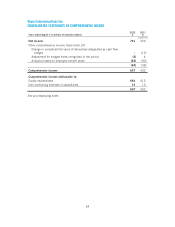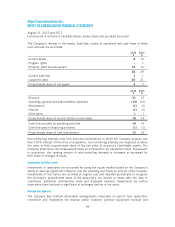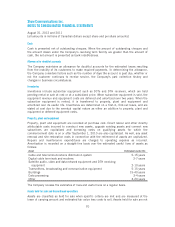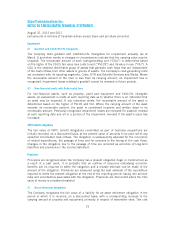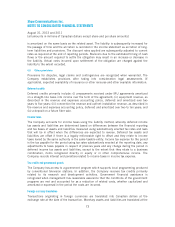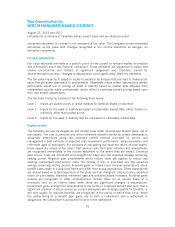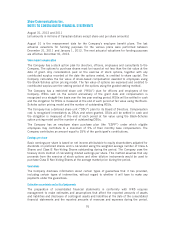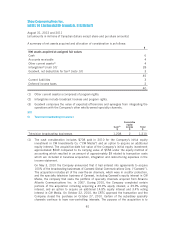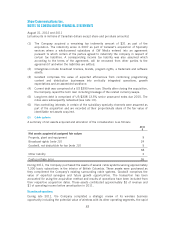Shaw 2012 Annual Report Download - page 78
Download and view the complete annual report
Please find page 78 of the 2012 Shaw annual report below. You can navigate through the pages in the report by either clicking on the pages listed below, or by using the keyword search tool below to find specific information within the annual report.Shaw Communications Inc.
NOTES TO CONSOLIDATED FINANCIAL STATEMENTS
August 31, 2012 and 2011
[all amounts in millions of Canadian dollars except share and per share amounts]
period-end rate of exchange and non-monetary items are translated at historic exchange rates.
The net foreign exchange gain recognized on the translation and settlement of current monetary
assets and liabilities was $nil (2011 – $4) and is included in other gains.
Exchange gains and losses on translating hedged and unhedged long-term debt are included in
the consolidated statements of income. Foreign exchange gains and losses on hedging
derivatives are reclassified from other comprehensive income (loss) to income to offset the
foreign exchange adjustments on hedged long-term debt.
Financial instruments other than derivatives
Financial instruments have been classified as loans and receivables, assets available-for-sale,
assets held-for-trading or financial liabilities. Cash has been classified as held-for-trading and is
recorded at fair value with any change in fair value immediately recognized in income (loss).
Other financial assets are classified as available-for-sale or as loans and receivables.
Available-for-sale assets are carried at fair value with changes in fair value recorded in other
comprehensive income (loss) until realized. Loans and receivables and financial liabilities are
carried at amortized cost. None of the Company’s financial assets are classified as
held-to-maturity and none of its financial liabilities are classified as held-for-trading.
Finance costs, discounts and proceeds on bond forward contracts associated with the issuance
of debt securities and fair value adjustments to debt assumed in business acquisitions are
netted against the related debt instrument and amortized to income using the effective interest
rate method. Accordingly, long-term debt accretes over time to the principal amount that will be
owing at maturity.
Derivative financial instruments
The Company uses derivative financial instruments to manage risks from fluctuations in foreign
exchange rates and interest rates. These instruments include cross-currency interest rate
exchange agreements, foreign currency forward purchase contracts and bond forward contracts.
All derivative financial instruments are recorded at fair value in the statement of financial
position. Where permissible, the Company accounts for these financial instruments as hedges
which ensures that counterbalancing gains and losses are recognized in income in the same
period. With hedge accounting, changes in the fair value of derivative financial instruments
designated as cash flow hedges are recorded in other comprehensive income (loss) until the
variability of cash flows relating to the hedged asset or liability is recognized in income (loss).
When an anticipated transaction is subsequently recorded as a non-financial asset, the amounts
recognized in other comprehensive income (loss) are reclassified to the initial carrying amount
of the related asset. Where hedge accounting is not permissible or derivatives are not
designated in a hedging relationship, they are classified as held-for-trading and the changes in
fair value are immediately recognized in income (loss).
Instruments that have been entered into by the Company to hedge exposure to foreign exchange
and interest rate risk are reviewed on a regular basis to ensure the hedges are still effective and
that hedge accounting continues to be appropriate.
Derivatives embedded in other financial instruments or contracts are separated from their host
contracts and separately accounted for as derivatives when their economic characteristics and
risks are not closely related to the host contract, they meet the definition of a derivative and the
74


